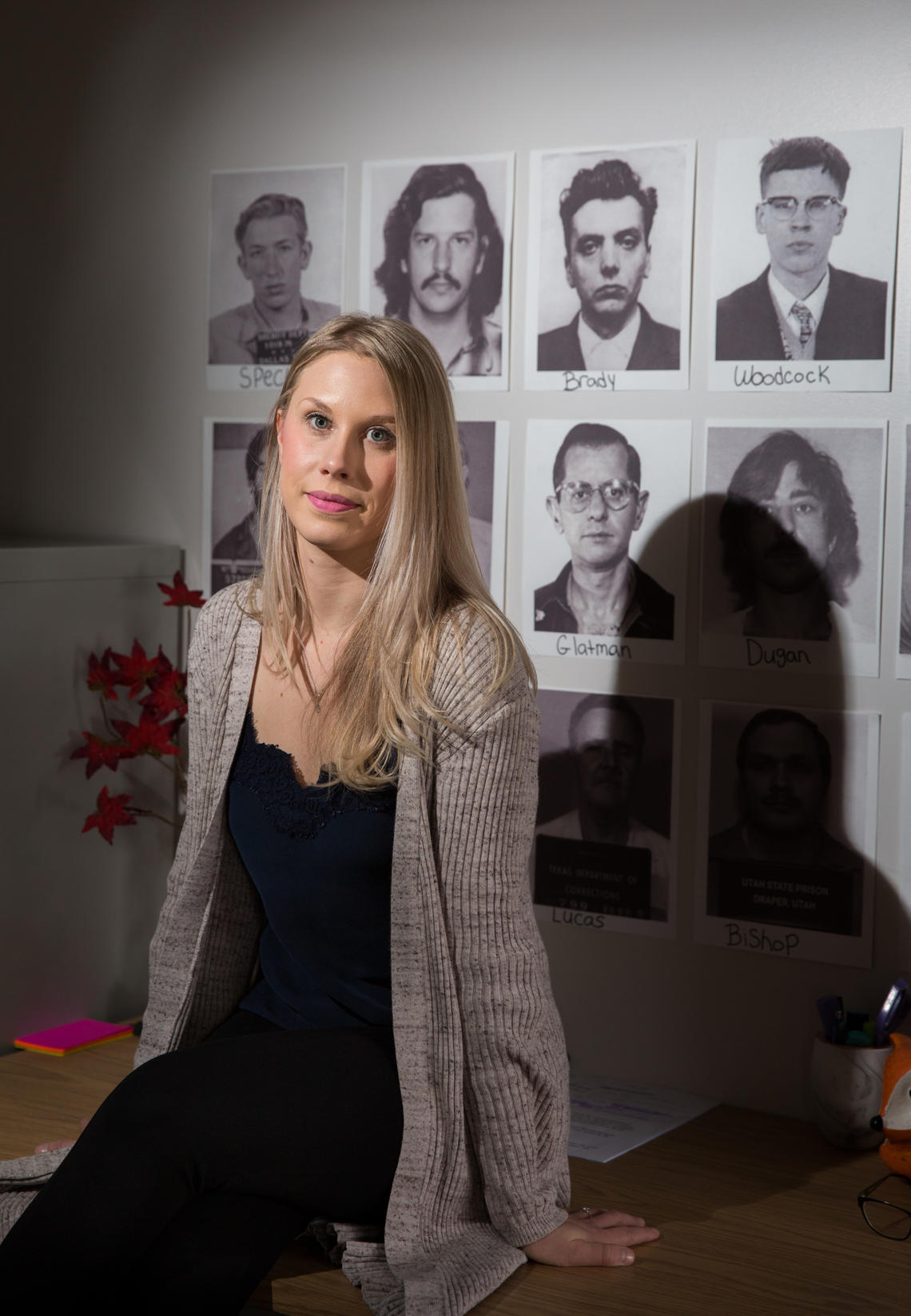Feb. 11, 2019
Intensive serial killer database garners media buzz

Sasha Reid has compiled what may become the most comprehensive serial killer database in the world.
Riley Brandt, University of Calgary
Each day when Sasha Reid sits at her desk in her shared 10th floor office in the Social Sciences building at the University of Calgary, she looks upon the chilling mugshots of some of the most notorious serial killers of our times.
Among the ghoulish 15 she’s posted on her wall, there is “The Killer Clown,” John Wayne Gacy, and “The Milwaukee Cannibal,” Jeffrey Dahmer. Ted Bundy, linked to the murders of at least 30 women, executed in 1989, and Ed Kemper, currently serving eight life sentences for his crimes, including the gruesome killing of his own mother, also stare back at her.
Reid doesn’t flinch. The recently recruited sessional instructor in both the University of Calgary sociology and psychology departments — currently completing her PhD in developmental psychology from the University of Toronto — is fascinated with such men and she’s dedicated her academic career to finding out what made them tick. What moulded them and led them down their monstrous paths? What are the connections between these men and what can we learn from them?
It's a line of research that has huge appeal. Over the past year Reid has been featured in a number of high-profile media outlets including the Toronto Star, Vanity Fair, CTV News, and Vice.com. She’s also set to appear soon in a Netflix documentary series on “The Unabomber,” Ted Kaczynski.
What’s drawn media to Reid is an exhaustive project she’s been working on for the past six years, compiling what may become the most comprehensive serial killer database in the world. It includes 645 variables on the behavioral and psychological development of 6,250 known serial killers, dating back to the 15thcentury. Two years ago, she also began compiling an in-depth missing persons database, which includes over 10,000 missing persons and unsolved homicides.
When it comes to the profiling of serial killers, Reid’s approach is highly critical. “If you look at the history of profiling, it’s riddled with issues,” she says. “It’s been more of an art than a science. There have been cases where profiles have actually thrown police off track and others have died because of it. It’s important that profiles be based on hard statistics. Because that makes it more of a science, and that’s the approach I’ve taken.”
Most serial killer databases rely primarily on static traits with very basic questions. Was the subject abused as a child? Were they married? Did they have a criminal past? “This contributes to research that is overly simplistic and invalidly reductionistic,” Reid explains.
“My database goes far beyond this because I approach it as a developmental psychologist, so, chronological age is important to me,” Reid explains. “I will ask, ‘Was there child abuse, yes or no?’ but then take it much further. At what age did the abuse begin? When did it end? What kind of abuse was it? Who was the abuser — mom, dad, stepdad, mom’s boyfriend?”
The 645 variables in her database span from the killers’ pre-conception to death, says Reid, and when she says she’s looking at every microscopic piece of data she can get her hands on, she’s not kidding. “What was going on in the parents’ background prior to conception?” she asks. “Were they in a house with lead-based paint? Was the father an alcoholic? Was mom doing drugs or drinking during the pregnancy? Then we look at the childhood. Were they born with any abnormalities? Were their birthing complications? Maybe an umbilical cord wrapped around their necks? Was it a breached birth?
“We look at everything down to the microdetails and I don’t think prior databases have done so.”
Reid has also found that previous databases lack the voice of the killers. “Offenders are viewed as objects of research and passive participants in their own life experiences,” she says.
That’s why her database includes “qualitative information” derived from diaries, home videos and interviews with the killers. This has been invaluable, she says, because it has provided insight into the way the killers have interpreted their respective environments and life experiences.
“When you look at their lives, at first, there’s so little that connects them,” says Reid, motioning to her wall of murderer mugshots. “Some of them are from poor families and some are rich. Some are from non-abusive families, some experienced extreme abuse. It’s all over the map!”
But looking at the ways they’ve interpreted their respective worlds is helping Reid find developmental links between her subjects — for example, in the way the killers tend to process and conceptualize death.
“It’s important to see them as human, because they are,” she adds. “Pop culture and the public make them monsters, but they’re not. They weren’t born out of fire, they were born the same way you and I were born. It’s what happened along the way. There was a very complicated series of accumulated risk factors at play that led them down this path, to an expression of deep, maladjusted psychopathology. This begins in early childhood.
“It’s important to learn what happened.”
